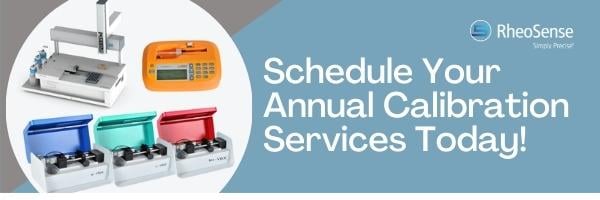RheoSense encourages routine maintenance of all VROC® viscometers and chips, including an annual calibration. As you work through prioritization for your laboratory tasks and expenditures you may find yourself asking "why do we need a calibration", or "why can't we calibrate in-house"?
Imagine if you're trying to use a gauge for your measurements and the gauge is not calibrated. Annual calibration is important to ensure accuracy and repeatability of your viscosity measurements. This annual calibration also ensures you are not in violation of any SOPs.
RheoSense runs a thorough calibration on our VROC viscometers and chips. Our calibration process consists of a complete inspection, standards checks, pressure calibrations, viscosity calibrations, and cleaning. To give our customers a better understanding of the importance of yearly calibrations and the rigorous steps our technicians take we are outlining the entire calibration process.
Inspection
When a viscometer or chip is received for annual calibration the process begins with a thorough inspection. VROC chips are checked against the UTI (Universal Transducer Interface) database to check that all 4 MEMS pressure sensors are within the recommended range. Chips are then checked for total number of runs as well as the last sample run and are cleaned appropriately based on that last sample run. Each VROC chip has an approximate lifespan of 4,000 - 5,000 runs, or 4-5 years if properly cared for. Once inspected, chips then move to the first step of the calibration process.
Each VROC viscometer motor/pump is tested to ensure the current is within safety specifications. Rate sweeps are also performed on the microVISC and m-VROC viscometers to confirm accurate p scale percentage readings and repeatability. The VROC initium one plus automatic viscometer is also checked for leaks along all tubing, fittings and bottle caps. The syringe and switch valves are also inspected for proper flow.
Calibration
Pressure calibrations are run on all VROC chips. This calibration consists of both pressure constant and pressure ramp testing to confirm safety UTI. Nitrogen is run through the chips to check for any leaks. Using a pressure controller RheoSense service technicians are able to perform temperature calibrations and check max flow rate and pressure of the chip to ensure it is within the safety range.
 Figure 1: Comparison of good (left) vs. bad (right) UTI scan
Figure 1: Comparison of good (left) vs. bad (right) UTI scan
Viscosity calibrations are also run on all VROC chips. Viscosity calibrations confirm chip reading accuracy and repeatability. Shear rate sweeps are run to confirm Rsqrd values and percentage errors fall within the expected range. Following viscosity calibrations chips are cleaned, dried and prepared to be returned to the customer.
If either calibration test is failed the chip is opened up and flow channels are inspected to determine if there are fibers or residue build up causing the issue. After a more in-depth inspection the RheoSense service engineer is able to determine if the chip needs to undergo cleaning protocols to be calibrated or if the chip requires replacement.
**Did you know your viscometer unit can be calibrated on site or at our service location? VROC chips can be sent to our service location for extensive calibration procedures.
Contact us to learn more about our extensive calibration process or to schedule your annual calibration services!
Written by: Eden Reid, Senior Marketing and Sales Operations


.jpg?width=300&name=VROC%20Viscometers%20(blog).jpg)

